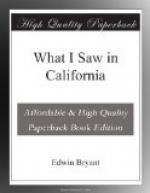While enjoying the pic-nic with our agreeable hostess, a caballada was driven into the corral by two vaqueros, and two gentlemen soon after came into the house. They were Messrs. Lightson and Murphy, from the Pueblo, bound for San Francisco, and had stopped to change their horses. We immediately made ready to accompany them, and were soon on the road again, travelling at racehorse speed; these gentlemen having furnished us with a change of horses, in order that we might be able to keep up with them.
To account for the fast travelling in California on horseback, it is necessary to explain the mode by which it is accomplished. A gentleman who starts upon a journey of one hundred miles, and wishes to perform the trip in a day, will take with him ten fresh horses and a vaquero. The eight loose horses are placed under the charge of the vaquero, and are driven in front, at the rate of ten or twelve miles an hour, according to the speed that is required for the journey. At the end of twenty miles, the horses which have been rode are discharged and turned into the caballada, and horses which have not been rode, but driven along without weight, are saddled and mounted and rode at the same speed, and so on to the end of the journey. If a horse gives out from inability to proceed at this gait, he is left on the road. The owner’s brand is on him, and, if of any value, he can be recovered without difficulty. But in California no one thinks of stopping on the road, on account of the loss of a horse, or his inability to travel at the rate of ten or twelve miles an hour. Horseflesh is cheap, and the animal must go as long as he can, and when he cannot travel longer he is left, and another horse is substituted.




